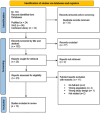Can a diet rich in Brassicaceae help control Helicobacter pylori infection? A systematic review
- PMID: 39741515
- PMCID: PMC11685009
- DOI: 10.3389/fmed.2024.1454902
Can a diet rich in Brassicaceae help control Helicobacter pylori infection? A systematic review
Abstract
Introduction: Helicobacter pylori (Hp) infection is highly prevalent globally and poses a significant public health challenge due to its link with chronic gastritis, peptic ulcers, and gastric malignancies. Hp's persistence within the gastric environment, particularly in case of infection with virulent strains, triggers chronic inflammatory responses and mucosal damage. Antibiotic therapy is the primary approach for Hp eradication, but antibiotic resistance and adverse effects hinder treatment efficacy. Emerging evidence suggests that Brassicaceae-derived metabolites could serve as adjunctive therapy for Hp infection, offering potential antimicrobial and anti-inflammatory benefits.
Methods: A systematic literature review was conducted following PRISMA guidelines to assess the impact of Brassicaceae-rich diets on Hp infection control. Searches were performed in MEDLINE PubMed, Web of Science, and the Cochrane Library until 18 October 2023, without language or date restrictions. Eligible studies meeting PICOS criteria were included, encompassing populations infected with Hp or Hp-infected human cell cultures, interventions involving Brassicaceae consumption or its bioactive molecules, and outcomes related to Hp infection control, antibiotic therapy interactions, reduction of antibiotic side effects, and inflammation mitigation. Animal studies, cell line experiments, reviews unrelated to the research objectives, and studies on Hp-related gastric cancer were excluded.
Results: Available evidence indicates that Brassicaceae consumption exhibits the potential to reduce Hp colonization but achieving complete eradication of the pathogen remains challenging. Conflicting results regarding the efficacy of broccoli in Hp treatment emerge, with certain investigations suggesting limited effectiveness. Other studies point to a potential for heightened eradication rates when combined with standard triple therapy. Furthermore, promising outcomes are observed with broccoli extract supplements, indicating their role in mitigating Hp-induced gastric mucosal damage. In fact, it is noteworthy that sulforaphane and its derivatives manifest notable reductions in pro-inflammatory markers, indicative of their anti-inflammatory properties. Adverse events associated with antibiotic therapy seem unaffected by sulforaphane derivatives or probiotics. However, individual responses to these treatments vary, underscoring the unpredictability of their efficacy in ameliorating antibiotic therapy-related side effects.
Conclusion: Our systematic review highlights the potential of Brassicaceae-rich diets as adjunctive therapy for Hp infection, offering synergistic interactions with antibiotics and possibly mitigating antibiotic side effects and inflammation. Further research, particularly well-designed randomized trials, is warranted to elucidate the therapeutic efficacy and optimal utilization of Brassicaceae-derived metabolites in managing human Hp-related diseases.
Keywords: Brassicaceae plants; Helicobacter pylori; Helicobacter pylori infections/diagnosis; glucosinolates; thiocyanate.
Copyright © 2024 Properzi, Stracci, Rosi, Lupi, Villarini and Gili.
Conflict of interest statement
The authors declare that the research was conducted in the absence of any commercial or financial relationships that could be construed as a potential conflict of interest. The author(s) declared that they were an editorial board member of Frontiers, at the time of submission. This had no impact on the peer review process and the final decision.
References
Publication types
LinkOut - more resources
Full Text Sources
Research Materials
Miscellaneous


